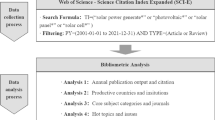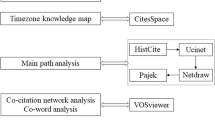Abstract
To meet the energy requirements of sustainable economic growth, policymakers, analysts, and business leaders have increasingly turned to the role that energy efficiency might play. This has resulted in a growing energy efficiency literature, which is examined in this paper. Using bibliometric techniques, we analyze the database of Science Citation Index Expanded and Social Sciences Citation Index covering the 1991–2010 period. Of the 8,244 publications, 78.8 % were journal articles, and about 95.5 % were published in English. Based on the h-index, an evaluative indicator, the USA has produced the most influential set of publications on energy efficiency, followed by Canada, UK, Japan, and China. In contrast, China is second to the USA in the volume of its publications. Correspondingly, the University of California at Berkeley, Chinese Academy of Sciences, and Tsinghua University were the most productive research organizations. The three most common subjects examined in this body of research were “energy and fuels”, “environmental sciences”, and “electrical and electronic engineering”. Energy Policy has been the most productive journal, and “A water and heat management model for proton-exchange-membrane fuel-cells”, has had the most citations (587 through May 2012). Based on an analysis of article titles and keywords, we conclude that the hotspots of energy efficiency research have been green communications, renewable energy, and energy sustainability; green communications, in particular, has developed rapidly as a focus of energy efficiency publications in recent years.





Similar content being viewed by others
References
Brown, M. A., & Sovacool, B. K. (2012). Climate change and global energy security: technology and policy options. Cambridge: Massachusetts Institute of Technology Press.
Chen, S. R., Chiu, W. T., & Ho, Y. S. (2005). Asthma in children: mapping the literature by bibliometric analysis. Revue Francaise d Allergologie et d Immunologie Clinique, 45(6), 442–446.
Chiu, W. T., & Ho, Y. S. (2007). Bibliometric analysis of tsunami research. Scientometrics, 73(1), 3–17.
Chuang, K. Y., Huang, Y. L., & Ho, Y. S. (2007). A bibliometric and citation analysis of stroke-related research in Taiwan. Scientometrics, 72(2), 201–212.
Cronin, B., & Meho, L. (2006). Using the h-index to rank influential information scientists. Journal of the American Society for Information Science and Technology, 57(9), 1275–1278.
Fouquet, R., & Pearson, P. J. G. (1998). A thousand years of energy use in the United Kingdom. The Energy Journal, 19(4), 1–41.
Fu, H.-Z., Ho, Y.-S., Sui, Y.-M., & Li, Z.-S. (2010). A bibliometric analysis of solid waste research during the period 1993–2008. Waste Management, 30, 2410–2417.
Garfield, E. (1979). Is citation analysis a legitimate evaluation tool? Scientometrics, 1(4), 359–375.
Garfield, E. (1990a). Keywords Plus: ISI’s breakthrough retrieval method. Part 1. Expanding your searching power on current contents on diskette. Current Contents, 32, 5–9.
Garfield, E. (1990b). Keywords Plus TM takes you beyond title words. 2. Expanded journal coverage for current contents on diskette, includes social and behavioral sciences. Current Contents, 33, 5–9.
Hirsch, J. E. (2005). An index to quantify an individual’s scientific research output. Proceedings of the National Academy of Sciences USA, 102(46), 16569–16572.
Hirsch, J. E. (2007). Does the h index have predictive power? Proceedings of the National Academy of Sciences USA, 104(49), 19193–19198.
Ho, Y. S. (2007). Bibliometric analysis of adsorption technology in environmental science. Journal of Environmental Protection Science, 1, 1–11.
Hofman, K., & Li, X. G. (2009). Canada’s energy perspectives and policies for sustainable development. Applied Energy, 86(4), 407–415.
IEA (International Energy Agency). (2008). World energy outlook 2008. Paris: IEA.
Kajikawa, Y., Yoshikawa, J., Takeda, Y., & Matsushima, K. (2008). Tracking emerging technologies in energy research: toward a roadmap for sustainable energy. Technological Forecasting and Social Change, 75, 771–782.
Kinney, A. L. (2007). National scientific facilities and their science impact on nonbiomedical research. Proceedings of the National Academy of Sciences, 104(46), 17943–17947.
Li, L. L., Ding, G. H., Feng, N., Wang, M. H., & Ho, Y. S. (2009). Global stem cell research trend: bibliometric analysis as a tool for mapping of trends from 1991 to 2006. Scientometrics, 80, 39–58.
Lovins, A. B. (2007). Energy myth nine—energy efficiency improvements have already reached their potential. In B. K. Sovacool & M. A. Brown (Eds.), Energy and American society—thirteen myths (pp. 239–263). New York: Springer.
Luis, P.-L., Jose, O., & Christine, P. (2007). A review on buildings energy consumption information. Energy and Buildings, 40(3), 394–398.
Nguyen, T. V., & White, R. E. (1993). A water and heat management model for proton-exchange-membrane fuel cells. Journal of the Electrochemical Society, 140, 2178–2186.
Ni, W. D., & Johansson, T. B. (2004). Energy for sustainable development in China. Energy Policy, 32(10), 1225–1229.
Rodríguez, K., & Moreiro, J. A. (1996). The growth and development of research in the field of ecology as measured by dissertation title analysis. Scientometrics, 35(1), 59–70.
Shao, M., Tang, X. Y., & Zhang, Y. H. (2006). City clusters in China: air and surface water pollution. Frontiers in Ecology and the Environment, 4(7), 353–361.
Tsay, M.-Y. (2008). A bibliometric analysis of hydrogen energy literature, 1965–2005. Scientometrics, 75(3), 421–438.
Van Raan, A. F. J. (2004). Measuring science. Capita selecta of current main issues. In H. F. Moed, W. Glänzel, & U. Schmoch (Eds.), Handbook of quantitative science and technology research (pp. 19–50). Dordrecht: Kluwer.
Van Raan, A. F. J. (2005). For your citations only? Hot topics in bibliometric analysis. Measurement: interdisciplinary research and perspectives, 3(1), 50–62.
Vieira, E. S., & Gomes, J. A. N. F. (2011). An impact indicator for researchers. Scientometrics, 89(2), 607–629.
Wallin, J. A. (2005). Bibliometric methods: pitfalls and possibilities. Basic & Clinical Pharmacology & Toxicology, 97, 261–275.
Wang, C. Y. (2004). Fundamental models for fuel cell engineering. Chemical Reviews, 104, 4727–4765.
Xie, S. D., Zhang, J., & Ho, Y. S. (2008). Assessment of world aerosol research trends by bibliometric analysis. Scientometrics, 77, 113–130.
Younis, O., & Fahmy, S. (2004). HEED: a hybrid, energy-efficient, distributed clustering approach for ad hoc sensor networks. IEEE Transactions on Mobile Computing, 3(4), 366–379.
Zhang, G. F., Xie, S. D., & Ho, Y. S. (2010a). A bibliometric analysis of world volatile organic compounds research trends. Scientometrics, 83(2), 477–492.
Zhang, L., Wang, M.-H., Hu, J., & Ho, Y.-S. (2010b). A review of published wetland research, 1991–2008: ecological engineering and ecosystem restoration. Ecological Engineering, 36(8), 973–980.
Acknowledgments
This work was supported by grant from the National Natural Sciences Foundation of China (70801042). Thanks to Dr. Yuh-Shan Ho of Trend Research Centre, Asia University, Taichung, Taiwan for the data statistics of this paper; Dr. Jim Dai of the Georgia Institute of Technology’s H. Milton Stewart School of Industrial and Systems Engineering for research support; and Joi N. Waddell of the Georgia Institute of Technology’s School of Public Policy for format assistance.
Author information
Authors and Affiliations
Corresponding author
Rights and permissions
About this article
Cite this article
Du, H., Wei, L., Brown, M.A. et al. A bibliometric analysis of recent energy efficiency literatures: an expanding and shifting focus. Energy Efficiency 6, 177–190 (2013). https://doi.org/10.1007/s12053-012-9171-9
Received:
Accepted:
Published:
Issue Date:
DOI: https://doi.org/10.1007/s12053-012-9171-9




